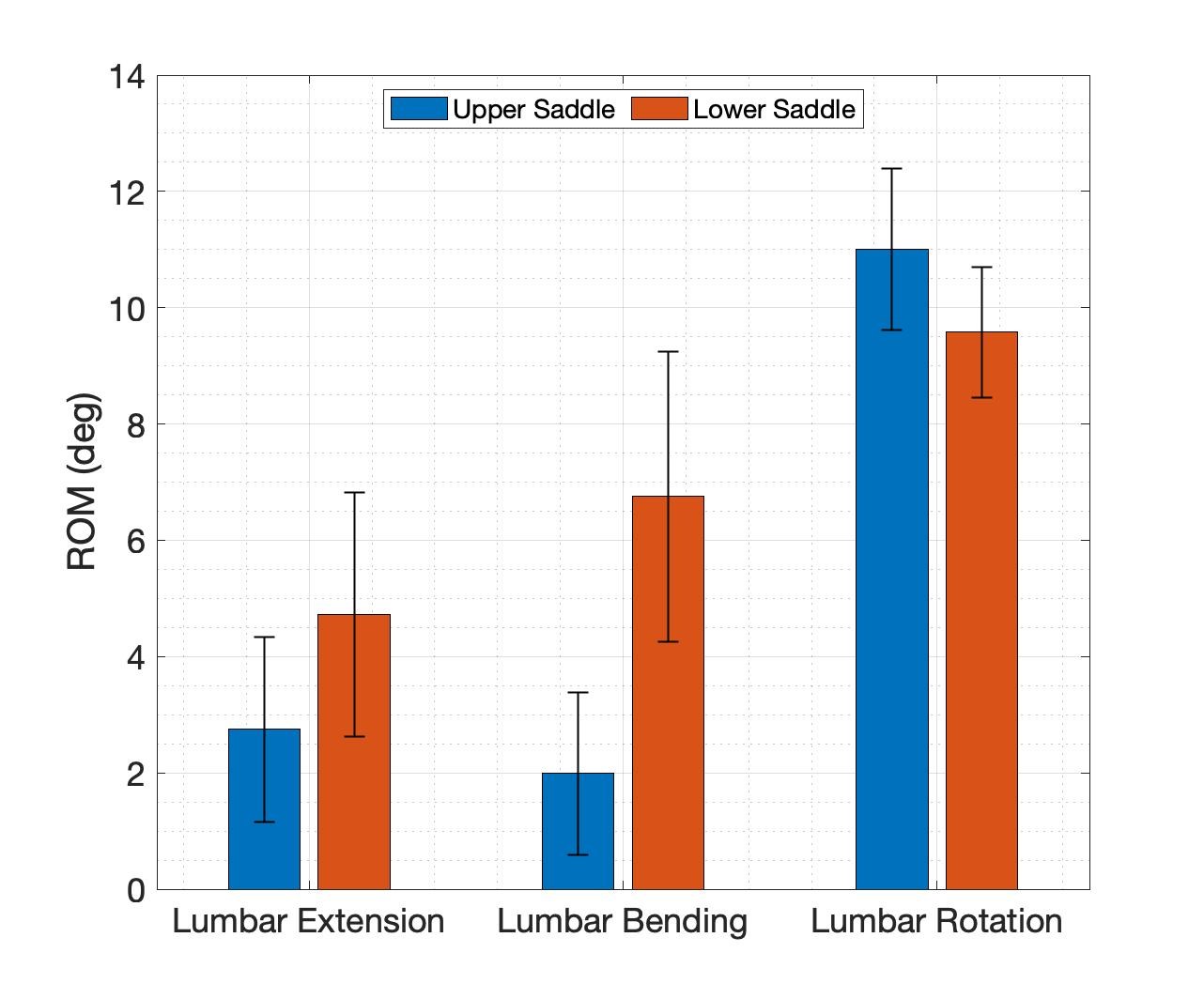Introduction
The cycling is Olympic sport and bicycle variable can influence on becoming champion. The lumbar spine is high-risk part of human body of athletes [1]. In addition, lumbar spine injuries are most common issues in riders that influenced by the range of motion (ROM). One of the important factors of bicycle variables is saddle heights [2]. The big challenge of sport engineers, sport medicines, coaches, and athletes are how they manipulate the best saddle height for each subject [3]. Therefore, the main goal of this study was to compare two different saddle height to find ROM of lumbar spine during cycling.
Research Question
What is the best saddle height to improve safety and increase performance?
Methods
Twenty professional and health subjects with more than ten years’ experience in professional cycling participated in this study (Mass: 75.3±6.5 kg, Heights: 180±6.3 cm, Age: 28.5±6.5 years). Ten Vicon motion captures (Vicon MX, Oxford, UK, 100 Hz) were used to measure the markers positions. The smart trainer (Tacx Flux, Netherland) was used to measure output power of bicycle. The inseam quantity (the distance from the uppermost of part of thigh to ankle) of each subject measured and then multiply to 0.883 to find standard saddle height that was choose as lower saddle. Then, we added the 4% to lower saddle height that was choose as upper saddle. The cadence remains at 60 rpm for times of cycling. The full body model used as base model in OpenSim [4]. The personalized model created for each subject by scaling tool. The joint angles were calculated by inverse kinematics [5].
Results
The figure 1 represents the mean and standard deviation of range of motion (ROM) of lumbar spine for two different saddle heights in three orientations (lumbar extension, lumbar bending, and lumbar rotation). According to the results, the lumbar extension and bending ROM for lower saddle was higher than upper saddle, while the rotation ROM for lower saddle was lower than upper saddle. The significant differences of ROM between lower and upper saddle were found only in lumbar bending (p<0.05). The main limitation of this study was we only used two saddle heights. Future study can compare more saddle heights.

Fig. 1. Mean and standard deviation of range of motion (ROM) of lumbar spine for two different saddle heights in three orientations (lumbar extension, lumbar bending, and lumbar rotation).
Discussion
The current study provides valuable information about the biomechanics of rider of bicycle. Based on the results, the saddle heights effect on lumbar ROM, therefore injury risk of lower saddle condition was higher than upper saddle condition due to ROM. The human body is kinematic chain which each joint effect on others therefore by changing the saddle height all joint influenced by saddle height. All coaches, athletes, and scientist in the field of bicycle can applied these results to find best height of saddle for specific subject.
References
[1] J. Swart and W. Holliday, “Cycling Biomechanics Optimization-the (R) Evolution of Bicycle Fitting.,” Curr. Sports Med. Rep., vol. 18, no. 12, pp. 490–496, Dec. 2019, doi: 10.1249/JSR.0000000000000665.
[2] V. Ferrer-Roca, A. Roig, P. Galilea, and J. García-López, “Influence of saddle height on lower limb kinematics in well-trained cyclists: static vs. dynamic evaluation in bike fitting.,” J. strength Cond. Res., vol. 26, no. 11, pp. 3025–3029, Nov. 2012, doi: 10.1519/JSC.0b013e318245c09d.
[3] V. Ferrer-Roca, R. Bescós, A. Roig, P. Galilea, O. Valero, and J. García-López, “Acute effects of small changes in bicycle saddle height on gross efficiency and lower limb kinematics.,” J. strength Cond. Res., vol. 28, no. 3, pp. 784–791, Mar. 2014, doi: 10.1519/JSC.0b013e3182a1f1a9.
[4] M. E. Raabe and A. M. W. Chaudhari, “An investigation of jogging biomechanics using the full-body lumbar spine model: Model development and validation,” J. Biomech., vol. 49, no. 7, pp. 1238–1243, May 2016, doi: 10.1016/J.JBIOMECH.2016.02.046.
[5] S. Martelli, G. Valente, M. Viceconti, and F. Taddei, “Sensitivity of a subject-specific musculoskeletal model to the uncertainties on the joint axes location,” Comput. Methods Biomech. Biomed. Engin., vol. 18, no. 14, pp. 1555–1563, 2015, doi: 10.1080/10255842.2014.930134.


